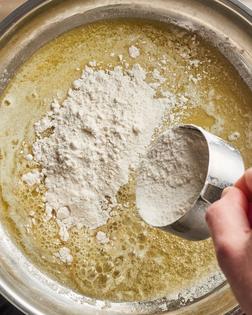The Kitchn: A newbie’s guide to making a roux
A roux, pronounced “roo,” is one of the building blocks of cooking. It’s a fundamental technique for new cooks to learn, and one of the first things taught in culinary school. It’s the secret to making silky sauces, rich gravies and luscious mac and cheese. In fact, if you’ve ever made a homemade cheese sauce before, chances are you’ve made a roux — even if you didn’t realize it.
A roux is a simple ratio of 50 percent butter to 50 percent flour. The butter gets melted, the flour is added, and the mixture gets cooked over low heat until it’s thick and lump-free. At this point, most recipes will instruct you to slowly add a liquid such as broth or milk, and this is where the magic happens. The roux dissolves into the liquid and thickens it into a silky-smooth sauce. Once you master the basic technique, you can transform just about any liquid into a perfectly smooth sauce.
What is a roux used for?
A roux is primarily used to thicken sauces such as gravies and cream sauces. Because the flour is cooked, you don’t have to worry about the flour clumping and ruining the texture of your sauce. (If you’ve ever tried to add flour directly into a hot liquid, you know what I’m talking about.) A roux should only be used to thicken sauces that are not meant to be clear, as it will turn a clear liquid cloudy. It’s the go-to tool for thickening pot pie filling, mac and cheese, and rich dairy sauces.
In less common instances, a roux can also be used to add flavor to a dish (such as gumbos and stews). In this case, the roux is slowly cooked down to intensify its nutty flavor. It transforms from a pale white color to dark mahogany and takes on a strong toasted flavor. These types of rouxs are used more for their flavor, not their thickening power; the longer you cook a roux the less thickening power it has.
Types of roux
Depending on how long you cook your roux, the color can range from pale white to dark brown. Each roux has its own unique use, and they are not interchangeable, so it’s important to know the differences.
1. White roux: A white roux is the most common type of roux used to thicken sauces. The flavor is mild and it has the strongest thickening power of all three roux types. It is most often used to thicken white sauces such as a béchamel, country gravy, and cheese sauce. It does not impart a noticeable color or flavor. It’s also somewhat thicker and more textured than darker rouxs. The longer you cook it, the smoother it becomes.
2. Blonde roux: Similar to a white roux, a blonde roux can be used to thicken any white sauce. It’s cooked for a few minutes longer than a white roux and develops a mild, nutty flavor. A blonde roux is traditionally used to thicken velouté (stock thickened with a roux) and has slightly less thickening power.
3. Brown roux: A brown roux is the least common type of roux and is used for only a handful of cooking applications. The flavor is strong and imparts a nutty, toasted flavor to whatever it is added to. Traditionally brown roux is used to thicken rich sauces such as sauce espagnole, and is one of the main flavoring components in gumbo. Brown roux has the least thickening power out of all three rouxs.
...continued







